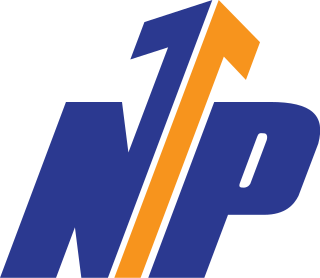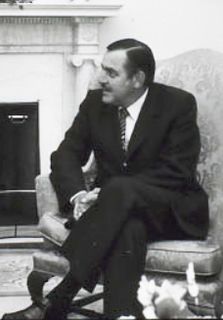Related Research Articles

Hendrik Frensch Verwoerd was a South African politician, a scholar of applied psychology and sociology, and chief editor of Die Transvaler newspaper. He is commonly regarded as the architect of Apartheid. Verwoerd played a significant role in socially engineering apartheid, the country's system of institutionalized racial segregation and white supremacy, and implementing its policies as Minister of Native Affairs (1950–1958) and then as prime minister (1958–1966). Furthermore, Verwoerd played a vital role in helping the far-right National Party come to power in 1948, serving as their political strategist and propagandist, becoming party leader upon his premiership. He was the Union of South Africa's last prime minister, from 1958 to 1961, when he proclaimed the founding of the Republic of South Africa, remaining its prime minister until his assassination in 1966.

The National Party, also known as the Nationalist Party, was a political party in South Africa founded in 1914 and disbanded in 1997. The party was an Afrikaner ethnic nationalist party that promoted Afrikaner interests in South Africa. However, in 1990 it became a South African civic nationalist party seeking to represent all South Africans. It first became the governing party of the country in 1924. It merged with its rival, the SAP, during the Great Depression, and a splinter faction became the official opposition during World War II and returned to power and governed South Africa from 4 June 1948 until 9 May 1994.

Balthazar Johannes "B. J." Vorster was a South African politician who served as the prime minister of South Africa from 1966 to 1978 and the fourth state president of South Africa from 1978 to 1979. Known as B. J. Vorster during much of his career, he came to prefer the anglicized name John in the 1970s.
The Afrikaner Broederbond (AB) or simply the Broederbond was an exclusively Afrikaner Calvinist and male secret society in South Africa dedicated to the advancement of the Afrikaner people. It was founded by H. J. Klopper, H. W. van der Merwe, D. H. C. du Plessis and the Rev. Jozua Naudé in 1918 as Jong Zuid Afrika until 1920, when it was renamed the Broederbond. Its influence within South African political and social life came to a climax with the 1948-1994 rule of the white supremacist National Party and its policy of apartheid, which was largely developed and implemented by Broederbond members. Between 1948 and 1994, many prominent figures of Afrikaner political, cultural, and religious life, including every leader of the South African government, were members of the Afrikaner Broederbond.

Roelof Frederik "Pik" Botha, was a South African politician who served as the country's foreign minister in the last years of the apartheid era, the longest-serving in South African history. Known as a liberal within the party, Botha served to present a friendly, conciliatory face on the regime, while criticised internally. He was a leading contender for the leadership of the National Party upon John Vorster's resignation in 1978, but was ultimately not chosen. Staying in the government after the first non-racial general election in 1994, he served under Mandela as Minister of Mineral and Energy Affairs from 1994 to 1996, and eventually joined the African National Congress (ANC) after his resignation.

Stellenbosch University is a public research university situated in Stellenbosch, a town in the Western Cape province of South Africa. Stellenbosch is the oldest university in South Africa and the oldest extant university in Sub-Saharan Africa, together with the University of Cape Town - which received full university status on the same day in 1918. Stellenbosch University designed and manufactured Africa's first microsatellite, SUNSAT, launched in 1999.
Great South Africans was a South African television series that aired on SABC3 and hosted by Noeleen Maholwana Sangqu and Denis Beckett. In September 2004, thousands of South Africans took part in an informal nationwide poll to determine the "100 Greatest South Africans" of all time. Votes were cast by telephone, SMS, and the website of the state-run South African Broadcasting Corporation television channel, SABC3, which aired a series of profiles and documentaries in the weeks leading up to the announcement of the top 100. The programme was modelled on the BBC's Greatest Britons series.

Antjie Krog is a South African writer and academic, best known for her Afrikaans poetry, her reporting on the Truth and Reconciliation Commission, and her 1998 book Country of My Skull. In 2004, she joined the Arts faculty of the University of the Western Cape as Extraordinary Professor.
The Cabinet of South Africa is the most senior level of the executive branch of the Government of South Africa. It is made up of the President, the Deputy President, and the Ministers.

A referendum on becoming a republic was held in South Africa on 5 October 1960. The Afrikaner-dominated right-wing National Party, which had come to power in 1948, was avowedly republican, and regarded the position of Queen Elizabeth II as head of state as a relic of British imperialism. The National Party government subsequently organised the referendum on whether the then Union of South Africa should become a republic. The vote, which was restricted to whites – the first such national election in the union – was narrowly approved by 52.29% of the voters. The Republic of South Africa was constituted on 31 May 1961.

The Herstigte Nasionale Party is a South African political party which was formed as a far-right splinter group of the now defunct National Party in 1969. The party name was commonly abbreviated as HNP, evoking the Herenigde Nasionale Party, although colloquially they were also known as the Herstigtes. The party is, unlike other splinter factions from the National Party, still active but politically irrelevant.
Jan Christiaan Smuts, OM was a prominent South African and Commonwealth statesman and military leader. He served as a Boer General duning the Boer War, a British General during the First World War and was appointed Field Marshal during the Second World War. In addition to various Cabinet appointments, he served as Prime Minister of the Union of South Africa from 1919 to 1924 and from 1939 to 1948. He played a leading part in the post war settlements at the end of both world wars, making significant contributions towards the creation of both the League of Nations and the United Nations.
Jan Christiaan Smuts, OM was a prominent South African and Commonwealth statesman and military leader. He served as a Boer general during the Boer War, a British general during the First World War and was appointed field marshal during the Second World War. In addition to various Cabinet appointments, he served as Prime Minister of the Union of South Africa from 1919 to 1924 and from 1939 to 1948. He played a leading part in the post war settlements at the end of both world wars, making significant contributions towards the creation of both the League of Nations and the United Nations.
Paul Roos Gymnasium is a public, dual medium high school for boys in the town of Stellenbosch, Western Cape, South Africa, and opened on the 1st of March 1866 as Stellenbosch Gymnasium. It is the 12th oldest school in the country.

Karel Schoeman was a South African novelist, historian, translator and man of letters. Author of twenty novels and numerous works of history, he was one of South Africa's most honoured writers. Schoeman wrote primarily in Afrikaans, although several of his non-fiction books were originally written in English. His novels are increasingly being translated into other languages, notably, English, French and Dutch.
Marion Monica Sparg is a South African activist, former guerrilla and public administrator.

Barend Jacobus "Ben" Schoeman was a South African politician of the National Party prominent during the apartheid era. He served as the Minister of Labour from 1948 to 1954, and the Minister of Transport from 1954 until 1974.
Henry Allan Fagan was the Chief Justice of South Africa from 1957 to 1959 and previously a Member of Parliament and the Minister of Native Affairs in J. B. M. Hertzog's government. Fagan had been an early supporter of the Afrikaans language movement and a noted Afrikaans playwright and novelist. Though he was a significant figure in the rise of Afrikaner nationalism and a long-term member of the Broederbond, he later became an important opponent of Hendrik Verwoerd's National Party and is best known for the report of the Fagan Commission, whose relatively liberal approach to racial integration amounted to the Smuts government's last, doomed stand against the policy of apartheid.

A Hertzoggie, also known in Afrikaans as a Hertzogkoekie or in English as a Hertzog Cookie, is a jam-filled tartlet or cookie with a coconut topping commonly served on a cup-like pastry base.
References
- ↑ "Kies invloedrykste Suid-Afrikaner". Beeld (in Afrikaans). 27 July 1999. Retrieved 3 February 2013.
- ↑ "Mandela gewildste in SA Tsafendas skop stof in Allan Boesak se oë". Beeld (in Afrikaans). 6 August 1999. Retrieved 3 February 2013.
- ↑ Pressly, Donwald (18 July 2003). "A statesman to all". Mail & Guardian. Retrieved 3 February 2013.
- ↑ Steyn, Jaap (11 January 2000). "Vergissing grotesk Internet-kiesers oor rol van taal". Beeld (in Afrikaans). Retrieved 3 February 2013.
- ↑ Naudé, Charles (29 November 1999). "Hulle in SA het ons eeu gevorm Meningsverskil oor invloedrykheid kan verwag word". Beeld (in Afrikaans). Retrieved 3 February 2013.